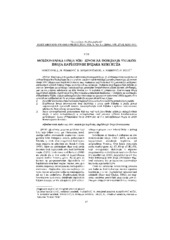Приказ основних података о документу
Moldovan line MHI the source for obtaining a large number of haploid plants in maize
Moldovanska linija MHI izvor za dobijanje velikog broja haploidnih biljaka kukuruza
| dc.creator | Vančetović, Jelena | |
| dc.creator | Vidaković, M. | |
| dc.creator | Ignjatović-Micić, Dragana | |
| dc.creator | Marković, Ksenija | |
| dc.creator | Delić, Nenad | |
| dc.date.accessioned | 2019-05-16T12:04:56Z | |
| dc.date.available | 2019-05-16T12:04:56Z | |
| dc.date.issued | 2004 | |
| dc.identifier.issn | 0354-5881 | |
| dc.identifier.uri | http://rik.mrizp.rs/handle/123456789/64 | |
| dc.description.abstract | The hypothesis of the shortening the cycle of selection was tested in maize, by using the MHI line (Moldovan Haploid Inducer) for inducing haploids in five F1 elite single crosses, made for the purposes of further inbreeding and gaining new elite inbred lines. Obtained number of haploid plants was quite enough for the further breeding, by using 15 F1 plants as the female parent for the Mill line as the male parent. Doubling of the chromosome number of a smaller number of haploids was quite successful. With such obtained dihaploid plants a 100% successful selfing and crossing with opposite testers was made. All of this gained to the conclusion that the process of breeding in maize could be conducted in three phases: 1. F1 x MHI for producing and selecting of haploids (could be done in the winter nurcery) 2. Doubling of the chromosome number of the obtained haploids and sowing this plants in the field along with the appropriate opposite testers. Selfing of this plants and outcrossing (as males) to the testers. 3. Sowing of selfed progenies ear to row for the phenotypic selection of the obtained dihaploid lines, and sowing of the test-crosses in the trials for the check of their combining ability. Only dihaploid lines which performe good per se and in the test-crosses could be further commercially used. | en |
| dc.description.abstract | Testirana je mogućnost skraćenja procesa selekcije, tj. dobijanja i testiranja novih inbred linija kod kukuruza na 2-3 godine, zavisno od korišćenja zimske generacije, uz pomoć linije MHI (Moldovan Haploid Inducer) kao inducera haploida kod F1 generacija dobijenih ukrštanjem elitnih inbred linija namenjenih za selekciju. Dobijeni broj haploidnih biljaka je sasvim dovoljan za selekciju (obuhvatanje genetičke varijabilnosti datih elitnih ukrštanju), ako se za početno ukrštanje sa MHI koristi po 15 biljaka F1 generacije. Kod manjeg broja haploidnih biljaka dupliranje broj hromozoma primenom kolhicina, i dobijene su normalno dihaploidne biljke, čija je samooplodnja i testiranje sa opozilnim testerima 100% uspelo. Ovo navodi na zaključak da bi se proces selekcije mogao skratiti na 3 faze: 1. F1 x MHI za proizvodnju i selekciju haploida (ovo se može uraditi i u zimskoj generaciji) 2. Dupliranje broja hromozoma kod haploida i setva ovih biljaka u polju pored odgovarajućih opozitnih testera, Samooplodnja ovih biljaka i njihovo istovremeno ukrštanje (kao očeva) sa testerima. 3. Setva samooplođenih potomstava klip na red radi fenotipske selekcije dihaploidnih linija, i setva test-ukrštanja u test-ogledima radi provere njihove kombinacione sposobnosti. Samo dihaploidne linije dobre per se i u test-ogledima mogu se dalje komercijalno koristiti. | sr |
| dc.publisher | Društvo selekcionara i semenara Republike Srbije, Beograd | |
| dc.rights | openAccess | |
| dc.rights.uri | https://creativecommons.org/licenses/by-sa/4.0/ | |
| dc.source | Selekcija i semenarstvo | |
| dc.subject | maize | en |
| dc.subject | MHI | en |
| dc.subject | haploid induction | en |
| dc.subject | chromosome doubling | en |
| dc.subject | kukuruz | sr |
| dc.subject | MHI | sr |
| dc.subject | indukcija haploida | sr |
| dc.subject | duplikacija broja hromozoma | sr |
| dc.title | Moldovan line MHI the source for obtaining a large number of haploid plants in maize | en |
| dc.title | Moldovanska linija MHI izvor za dobijanje velikog broja haploidnih biljaka kukuruza | sr |
| dc.type | article | |
| dc.rights.license | BY-SA | |
| dc.citation.volume | 10 | |
| dc.citation.issue | 1-4 | |
| dc.citation.spage | 27 | |
| dc.citation.epage | 30 | |
| dc.citation.other | 10(1-4): 27-30 | |
| dc.identifier.fulltext | http://rik.mrizp.rs//bitstream/id/2572/62.pdf | |
| dc.identifier.rcub | https://hdl.handle.net/21.15107/rcub_rik_64 | |
| dc.type.version | publishedVersion |


